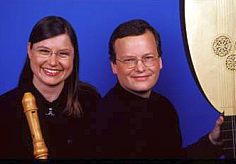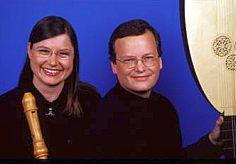
With tenor Thomas Cooley, one of the best early music tenors around today, Voices of Music scores heavily. He is partnered by Christopher LeCluyse, a highly-regarded, Austin-based singer who has been heard in the Bay Area at a few San Francisco Early Music Society events. Together they sing duets by Monteverdi and Heinrich Schütz, another of the heavy hitters in 17th-century composition.
Voices of Music is an idealistic group in many ways, as early music performance was in its pre-corporatized days. Tayler and van Proosdij take historical performance practice extremely seriously. They make it a point to play every concert, not just at the lower pitch we know was prevalent before the mid-19th century, but also in the dominant tuning system of the period ("mean tone" instead of today's "equal temperament"). Practically, this creates hurdles for the performers, since mean-tone tuning has two different-sized semitones. "I can't imagine doing it as a violinist," Tayler admits. "At least the lute has frets" (to help you place your fingers.)
The group's sense of adventure extends to rehearsal and performance — there are no leaders/ conductors. "Experienced musicians know when to contribute and when to be quiet," says Tayler. "People take risks when you encourage them to, and when you hire the best people you want [the audience] to hear their interpretation, their ideas.
Tayler and van Proosdij are committed to spreading the joy of early music. And with the advantage of affordable digital technology, the group is putting up their concerts and other music videos on their Web site, Vimeo, and YouTube. "By the middle of December, we'll have had one million online visitors," Tayler reports. Many of those people won't get to hear Voices of Music in the near future. But Bay Area denizens should not miss the opportunity.

